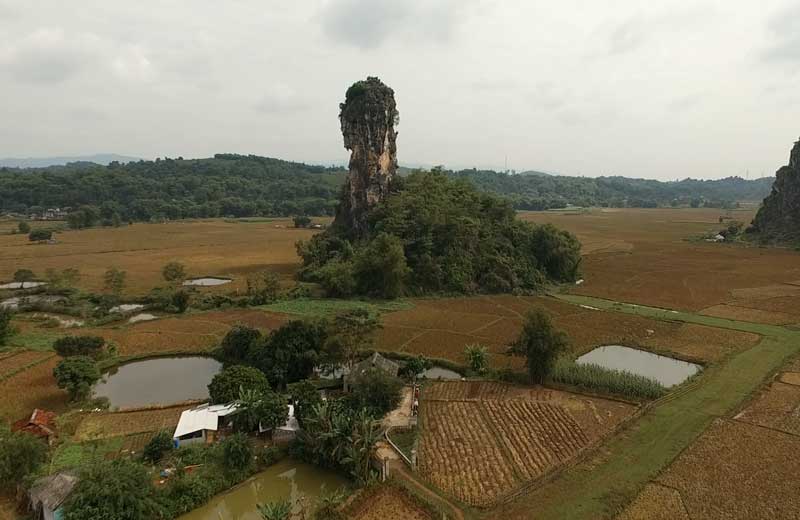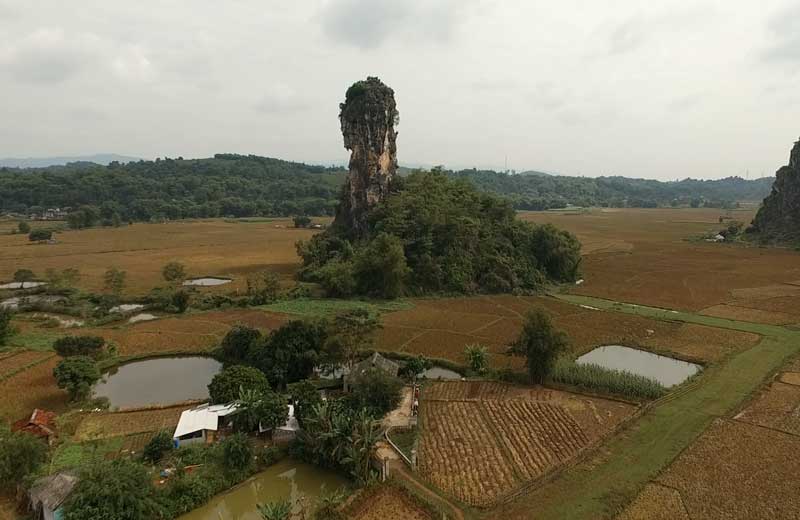
HBO – Located in Tuan Lo and Phong Phu communes, Cot Co Mountain (Khu Doi) is considered as a gift the nature offers to the area of Muong Bi in Tan Lac district. Since its appearance in the epic "De dat, de nuoc” (Giving birth to the Earth and the Water), Cot Co (Flagpole) Mountain has been a symbol in locals’ spiritual life. The mountain was officially recognised as a provincial-level landscape in November 2017, which multiplies the pride of locals and encourages people to find out Khu Doi’s legend.

Cot Co Mountain in Muong Bi area –
a cultural symbol honoured by Muong Bi locals as the most sacred mountain was
recognised as a provincial-level landscape in late 2017.
According to scientific documents stored by Hoa Binh Museum, Cot
Co (flagpole) cave is an archaeological relic belonging to the Stone Age in the
Hoa Binh Culture dating back from 30,000 to 11,000 years.
The legend has it that a feng shui master in the region, as
witnessing the poverty and difficulties facing locals, told people to find an
outstanding couple to become their leaders to expand their area.
The locals then found Tung, a man with extraordinary strength, and
his wife, a beautiful and resourceful woman, to lead them in building Muong
area. Under guidelines of the feng shui master, Tung and his wife directed
local people to build dams blocking Da River’s water, thus expanding farming
areas.
As they were building the dams, Tung, stronger and quicker, left
his wife behind when Sat, a muscular man from the nearby region went by. Enchanted
by the woman’s beauty, Sat kidnapped her and ran away. Tung chased Sat through
many mountains and hills to save his wife until he sunk into the mud and did
not able to get out. Tung desperately threw soil and rock into Sat, but in
vain. The soil and rock then became high mountains spanning Hoa Binh province
to Thanh Hoa province. After he died, Tung turned into a mountain standing in
the middle of a massive field. People called it Tung Mount (Khu Doi). Viewing
from far away, the mountain looks like a flagpole, thus locals also called it
Muong Bi Flagpole.
Boasting a mystical beauty with cultural, historical and spiritual values, Cot
Co Mountain has become an attractive tourist site. Visiting the site, tourists
can offer incense at a small temple. Those who like adventure can climb to the
top of the mountain where they enjoy the happiness of finishing an "unconquerable”
road, and seeing the scenery like a fairyland. The first thing that tourists
feel here is fresh air and the sound of mountain wind blowing through leaf
canopies. For those who cannot reach the top, visiting caves at the foot of the
mountain such as Nuoc, Cot Co Mountain (Chang Choanl), Cui and Ang Ca is also an
option../.
Located just a 20-minute drive from Hoa Binh City, Ora Hill Farmstay & Glamping Hoa Binh is a captivating new destination nestled in Mo hamlet, Bình Thanh commune, Cao Phong district. Combining farming with leisure, this tranquil retreat is perfect for those seeking balance, joy, and an immersive experience in the expansive beauty of nature.
Muong Bi - Tan Lac is renowned as one of the four famous Muong regions in Hoa Binh province. Blessed by nature with a favourable climate and stunning landscapes, Tan Lac holds great advantages for tourism development. The local tourism industry has made remarkable strides in recent times thanks to the attention and support from the local authorities and sectors.
With its strategic location, well-developed transport network, and diverse soil and climatic conditions, Hoa Binh is emerging as a must-visit destination in Vietnam's northwestern tourism corridor. The province boasts numerous attractions, including the Kim Boi hot springs (Kim Boi district), the Dau Rong cave complex (Cao Phong), the Mai Chau valley (Mai Chau), and the iconic Hoa Binh hydropower plant.
The northern mountainous province of Hoa Binh has been listed among the 71 most beautiful places to visit worldwide by the prestigious US travel magazine Condé Nast Traveller.
Hoa Binh province’s rich natural and cultural resources position it as a prime location for developing community-based tourism (CBT). In recent years, support from central and provincial policies, as well as assistance from non-governmental organisations, have encouraged local ethnic minority and mountainous communities to actively engage in the sector.



